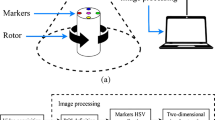Abstract
In order to accurately identify the thermally induced positioning errors, an improved measurement method is proposed based on the repeatability of a machine tool’s temperature rise process. Using this improved measurement method, the mismatches between the thermally induced positioning errors and the machine temperatures can effectively be avoided. To improve the modeling accuracy and efficiency, the least-square fitting of orthogonal polynomial method is used in this research. Using this error modeling method, the thermally induced positioning errors are fitted by 96.7 %. To realize the thermally induced positioning error compensation, a new error compensation method is proposed based on the network. Experimental results show that the thermally induced positioning errors are compensated by 92.6 % compared with no compensation.
Similar content being viewed by others
References
ASME B5.54 (1992) Methods for performance evaluation of computer numerical controlled machining centers. ASME
ISO 230–6 (2002) Test code for machine tools, part 6: determination of positioning accuracy on body and face diagonals (diagonal displacement tests). ISO
Wang C (2000) Laser vector measurement technique for the determination and compensation of volumetric positioning errors part I: basic theory. Rev Sci Instrum 71(10):3933–3937
Raksiri C, Parnichkun M (2004) Geometric and force errors compensation in a 3-axis CNC milling machine. Int J Mach Tools Manuf 44:1283–1291
Shen JH, Li YX, Lu ZZ, Chen ZJ, Yang JG (2008) A real-time compensation method for the geometric and thermal error on CNC turning machine. J Sichuan Univ (Eng Sci Ed) 40:163–166
Wang XS, Yang JG, Yan JY (2008) Synthesis error modeling of the five-axis machine tools based on multi-body system theory. J Shanghai Jiaotong Univ 42:761–764
Mustapha KB, Zhong ZW (2013) A hybrid analytical model for the transverse vibration response of a micro-end mill. Mech Syst Signal Process 34:321–339
Fan KG, Yang JG, Yang LY (2013) Orthogonal polynomials-based thermally-induced spindle and geometric error modeling and compensation. Int J Adv Manuf Technol 65:1791–1800
Fan KG, Yang JG, Yang LY (2014) Unified error model based spatial error compensation for four types of CNC machining center: part II—unified model based spatial error compensation. Mech Syst Signal Process 49:63–76
Zhao HT, Yang JG, Shen JH (2007) Simulation of thermal behavior of a CNC machine tool spindle. Int J Mach Tools Manuf 47:1003–1010
Fan KG, Yang JG, Wang W, Jiang H, Yao XD (2012) Error prediction and clustering compensation on shaft machining. Int J Adv Manuf Technol 58:663–670
Zheng FQ, Yang JG, Li BZ, Yan RZ, Xu Y (2008) Research on micro-feeding system applied to grinder. Manuf Technol Mach Tool 8:12–15
Author information
Authors and Affiliations
Corresponding author
Rights and permissions
About this article
Cite this article
Jiang, H., Fan, K. & Yang, J. An improved method for thermally induced positioning errors measurement, modeling, and compensation. Int J Adv Manuf Technol 75, 1279–1289 (2014). https://doi.org/10.1007/s00170-014-6193-9
Received:
Accepted:
Published:
Issue Date:
DOI: https://doi.org/10.1007/s00170-014-6193-9




